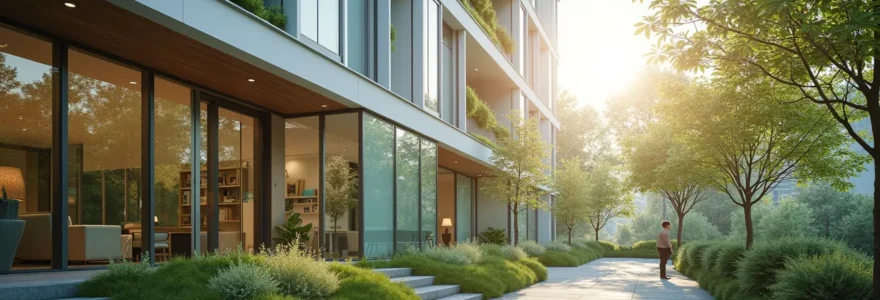For decades, windows were seen as passive openings—necessary for light and views, but fundamentally weak points in a building’s thermal defense. The best a window could do was slow down heat loss. This perspective is now obsolete. The revolution in sustainable architecture isn’t just about better insulation or solar panels; it’s happening right in the building envelope, where windows have transformed from static components into dynamic, intelligent systems that actively manage a building’s relationship with the environment.
This paradigm shift is driven by advanced material science and smart technology, allowing windows to control heat, harvest daylight, and even generate energy. Choosing a skilled window manufacturer is no longer just about frames and panes; it’s about integrating a core component of a building’s active performance strategy. These systems are central to creating structures that are not only energy-efficient but also healthier and more responsive to the needs of their occupants.
- From Passive to Active: Windows now dynamically control light, heat, and energy instead of just providing a static barrier.
- Advanced Material Science: Innovations like smart coatings, aerogels, and nanostructures deliver unprecedented thermal and spectral performance.
- Smart Integration: Seamless connection with building automation systems (BAS) optimizes energy use across HVAC and lighting.
- Holistic Value: Performance is now measured by occupant well-being, lifecycle costs, and resilience, not just energy savings.
Windows as Active Building Systems: Beyond Static Envelope Components
The most profound change in window technology is the move from a passive to an active role. High-performance windows are no longer mere openings but dynamic interfaces that intelligently manage the flow of energy and light. This evolution transforms the entire building facade into a responsive skin that adapts to changing conditions, a concept central to climate-adaptive building shells. Technologies like electrochromic and thermochromic glass can change their tint in response to electrical signals or temperature, blocking solar heat gain during peak sun while allowing natural light and warmth when needed.
This dynamic capability leads to significant performance gains. Predictive controls integrated into smart facades can achieve energy savings of up to 28% with smart dynamic facades by anticipating weather patterns and occupancy needs. This proactive management is a fundamental departure from traditional, reactive building systems.
By proactively anticipating weather and occupancy changes, MPC-based controls are fundamentally different from traditional building controls.
– Christoph Gehbauer, Lawrence Berkeley National Laboratory
What is dynamic glazing?
Dynamic glazing, often called smart glass, refers to window technologies that can change their light-transmitting properties. Technologies like electrochromic glass use an electrical charge to tint the window, allowing active control over heat and glare without blocking the view.
Beyond energy, this active management profoundly impacts occupant well-being. By maximizing natural daylight and preserving outdoor views without the associated glare or thermal discomfort, advanced glazing supports biophilic design principles. This connection to the outdoors is crucial for creating healthier, more productive indoor environments. The ability to eliminate mechanical blinds and shades also provides a cleaner, more minimalist aesthetic.

This functionality is not just theoretical; it is being implemented at scale. Large-scale installations demonstrate the real-world impact of dynamic facades on both energy consumption and the occupant experience, proving their viability for critical infrastructure and commercial buildings alike.
Smart window installation at San Francisco International Airport
San Francisco International Airport hosts one of the largest dynamic electrochromic window installations in an airport, demonstrating significant energy saving and occupant comfort improvements.
The Material Science Frontier: Engineering the Next Generation of Glazing
The revolution in window performance is built upon groundbreaking advances in material science. Innovations in glazing are pushing the boundaries of insulation and spectral control far beyond what traditional double-paned windows can offer. Materials like aerogels, which are incredibly light and porous, provide exceptional thermal insulation without sacrificing transparency.
Research has shown that novel materials can drastically improve performance metrics. For instance, certain designs can reduce thermal conductivity by up to 63% using aerogel glazing, significantly lowering heat transfer. As noted in a 2021 review in iScience, “Aerogel materials with super-insulating, visual-penetrable, and sound-proof properties are promising in buildings.” This multi-benefit profile is a hallmark of next-generation glazing materials.
Sustainability in manufacturing is also a key focus. The industry is moving towards circular economy principles by analyzing the embodied energy of materials, increasing the use of recycled content like aluminum for frames, and designing for recyclability. At the micro-level, nanotechnology is enabling the creation of smart coatings with unique properties, including self-cleaning surfaces and precise light manipulation, further enhancing both performance and longevity.
Key Considerations for Advanced Glazing Materials
- Evaluate thermal conductivity and insulation properties carefully.
- Incorporate machine learning models for multi-criteria performance prediction.
- Account for acoustic and visual performance in design.
- Consider environmental impact of raw material production and lifecycle sustainability.
Integration and Implementation: Overcoming Hurdles for Revolutionary Impact
The full potential of high-performance windows is only realized when they are seamlessly integrated into the building’s broader design and operational systems. A primary challenge is achieving synergy between cutting-edge performance and architectural aesthetics. The goal is to ensure these advanced systems complement diverse architectural styles rather than constraining them.
Even more critical is the synergy with smart building systems. For maximum efficiency, advanced windows must communicate with HVAC, lighting controls, and other IoT devices. This allows for a holistic approach where, for instance, the windows automatically tint to reduce solar gain, signaling the HVAC system to lower its cooling output. To Discover advantages of smart buildings is to understand this interconnected ecosystem. The development of open IoT standards is crucial for overcoming proprietary system silos, with collaborations showing a potential reduction of IoT integration effort by up to 80%. According to a joint announcement from Siemens and Microsoft, “Automatic device onboarding and standardized metadata enable straightforward integration and monitoring regardless of vendor.”
This table illustrates the leap from siloed, traditional systems to a modern, interconnected approach.
| Feature | Traditional Integration | Open-Standard IoT Integration |
|---|---|---|
| Ease of integration | Low, vendor-specific silos | High, vendor-agnostic and standardized |
| Setup time | Lengthy, complex | Reduced by up to 80% |
| Device onboarding | Manual, error-prone | Automated ‘one-click’ onboarding |
| Data accessibility | Fragmented and isolated | Centralized cloud-based access |
Projects that successfully merge these technologies serve as powerful case studies, demonstrating how integrated systems can fundamentally alter building function and energy management.
Siemens and Microsoft open-standard IoT integration for smart buildings
A breakthrough solution enabling seamless interoperability between HVAC, lighting, and other building systems via open IoT standards, facilitating optimized energy management in buildings with smart window technology.
Key Takeaways
- Windows have evolved from passive barriers into active, dynamic systems that manage a building’s energy and light.
- Advanced materials like aerogels and smart coatings are delivering unprecedented levels of insulation and spectral control.
- Seamless integration with building automation systems (BAS) is crucial for maximizing the energy and comfort benefits.
- The value of high-performance windows is measured holistically, including occupant well-being, lifecycle cost, and resilience.
Quantifying the Revolution: Holistic Performance, Lifecycle Value, and Future Trajectories
To truly grasp the impact of this revolution, performance metrics must expand beyond simple U-values. The role of high-performance windows in sustainable design now includes contributions to acoustic comfort, security, and indoor air quality. Advanced daylight harvesting, which reduces the need for artificial lighting, is another critical performance indicator that directly lowers operational costs.
The economic imperative is equally compelling. While the initial investment may be higher, a life-cycle cost analysis (LCCA) often reveals a strong long-term return on investment. The benefits range from direct energy savings—with potential annual energy cost savings of $101-$583 for certified windows—to increased property value and enhanced resilience against extreme weather. These windows improve a building’s ability to maintain safe temperatures during power outages, a critical advantage in an era of climate uncertainty.
Lifecycle cost comparison: double glazed vs triple glazed windows
Study showing double glazed windows have lower lifecycle cost compared to triple glazed windows by 1136 euros, while offering similar energy savings in typical use cases.
Looking ahead, the trajectory for window technology is aimed squarely at net-zero and regenerative architecture. Emerging research focuses on integrating photovoltaic cells directly into glass to create windows that are net energy producers. The continued advancement of materials and smart controls will further solidify the window’s role as one of the most critical and dynamic components in the sustainable buildings of the future.
High-performance windows lower building operational costs, reduce carbon emissions, and create skilled-labor opportunities through upgrades.
– National Glass Association, High-Performance Windows One-Pager 2023
The collective benefits of these advanced systems are substantial, touching on nearly every aspect of building performance, from energy use to economic impact.
| Benefit | Description |
|---|---|
| Energy Efficiency | Up to 80% more efficient than standard windows, reducing energy use and costs. |
| Carbon Reduction | Operational carbon offsets embodied carbon in under two years. |
| Building Resiliency | Improves temperature retention during blackouts and extreme weather. |
| Economic | Creates jobs through installation and urban renewal projects. |
Frequently Asked Questions on Sustainable Window Technology
Are high-performance windows only for new buildings?
No. While they are a cornerstone of new sustainable construction, many high-performance windows are designed for retrofitting existing buildings. Upgrading windows is one of the most effective ways to improve the energy efficiency and comfort of an older property.
What is the main difference between smart glass and regular low-E glass?
Low-E (low-emissivity) glass has a passive, permanent coating that reflects heat, improving insulation year-round. Smart glass (like electrochromic glass) is an active technology that can change its tint and heat-blocking properties on demand, offering dynamic control in response to conditions or user input.
Is the high initial cost of advanced windows worth it?
While the upfront cost can be higher than for standard windows, a life-cycle cost analysis often shows they are a worthwhile investment. The long-term savings on heating and cooling costs, combined with improved comfort, durability, and increased property value, typically provide a strong return.
How do high-performance windows contribute to occupant well-being?
They enhance well-being by providing abundant natural light without unwanted glare or heat, maintaining stable indoor temperatures, reducing outside noise, and offering clear views of the outdoors. These factors are linked to improved mood, productivity, and overall health.
